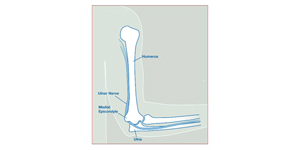 What is it?
What is it?
Not to be confused with Carpal Tunnel Syndrome, Cubital Tunnel Syndrome is a bump on the inside of the elbow, on the area known as the “funny bone.” The ulnar nerve is right next to this bone and is sensitive to pressure. When the pressure on this nerve builds up it can result in numbness, tingling, and pain that you can feel in the elbow, forearm, hand, and/or fingers.
What causes it?
The ulnar nerve doesn’t have much padding on it, so even a little pressure on this part of the elbow can put undue pressure on the nerve. You’ve probably experienced the sensation of your arm falling asleep after having leaned the inner part of your elbow on a table. If this keeps happening, the numbness and pain can become persistent. Some patients experience a clicking as the ulnar nerve passes over the bony bump when the elbow is bent and flexed. Over time, the nerve can become very irritated.
Keeping the elbow bent for long periods can also cause pressure on the ulnar nerve. This position may occur while you’re sleeping and you don’t even realize it. Eventually, the tissue that covers the nerve can thicken. Cubital Tunnel Syndrome happens when there is such significant pressure on the nerve that it disrupts normal nerve function.
What are the symptoms?
Pain, numbness and tingling are the usual symptoms of Cubital Tunnel Syndrome. Numbness and tingling are usually felt in the ring and pink fingers. Patients feel symptoms most when there is pressure on the nerve from resting the elbow on a surface, or from repeatedly bending and flexing. Some patients may feel more pain when doing common activities like holding the phone, cooking or even sleeping. Other signs of the syndrome may include weakness while doing pinching fingers, or a tendency to drop things.
How do we diagnose it?
Your doctor can evaluate your specific symptoms by observing muscle weakness, nerve response and sensation variations. The surgeon may want to assess the influence of other conditions such as thyroid disease or diabetes. An electromyography (EMG) and/or nerve conduction study (NCS) is used in diagnosing the presence and severity of the syndrome. NCS can also simultaneously check for other nerve issues which may be causing the symptoms.
How is it treated?
The EMG or NCS test may show that the nerve pressure is minimal, in which case surgery is not needed. You can significantly relieve symptoms by simply avoiding putting your elbow on hard surfaces or wearing an elbow pad. You may also consider using a splint that keeps your elbow straight when you sleep. A physical therapist can teach you several everyday solutions that will help you avoid putting unnecessary pressure on the ulnar nerve.
If these other solutions do not improve symptoms, surgery may be required to relieve the pressure. There are various surgical solutions, such as moving the nerve to the front of the elbow, placing it under a layer of fat or muscle or even trimming the bony bump. Recovery depends on the specific procedure used, and your doctor may recommend therapy. The abatement of symptoms can happen slowly or quickly. Full restoration of hand and wrist strength may take up to several months. Patients with more severe cases might not see a complete resolution of symptoms even after surgery.


